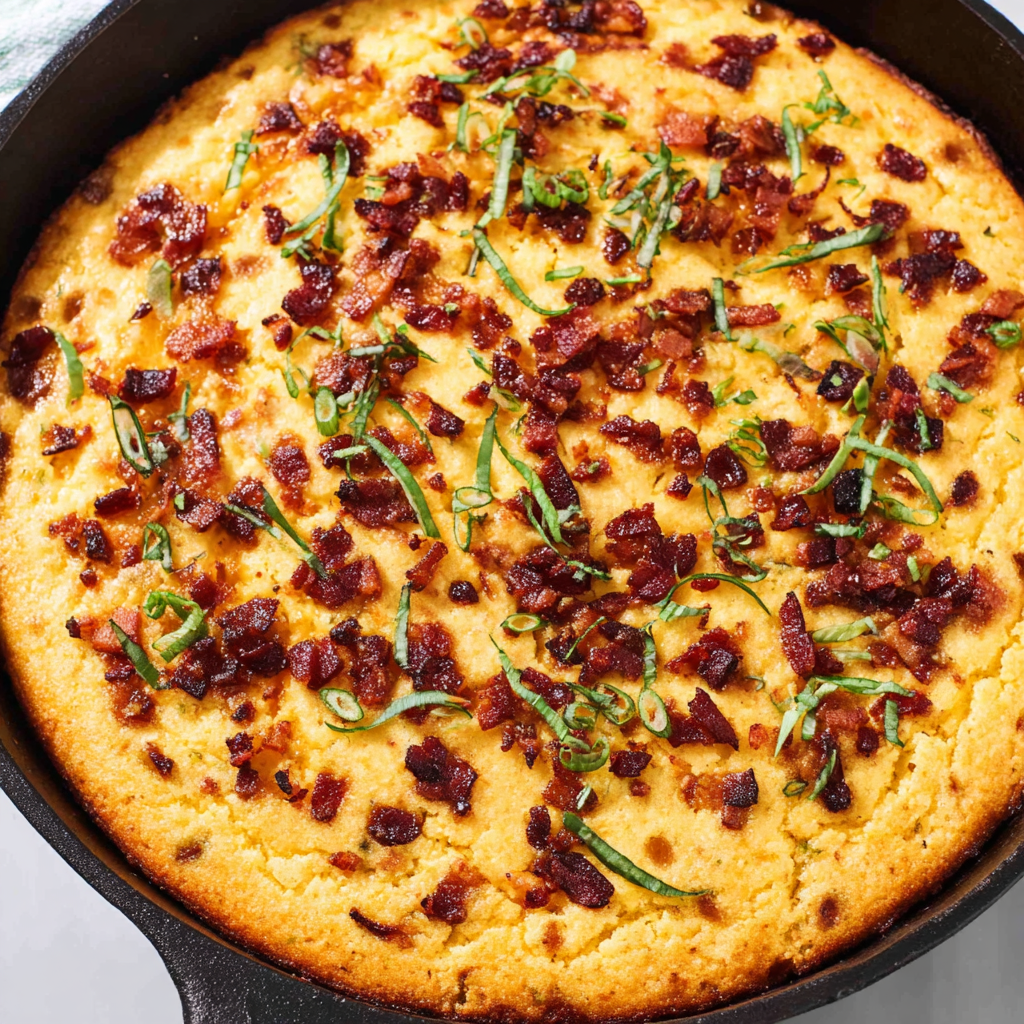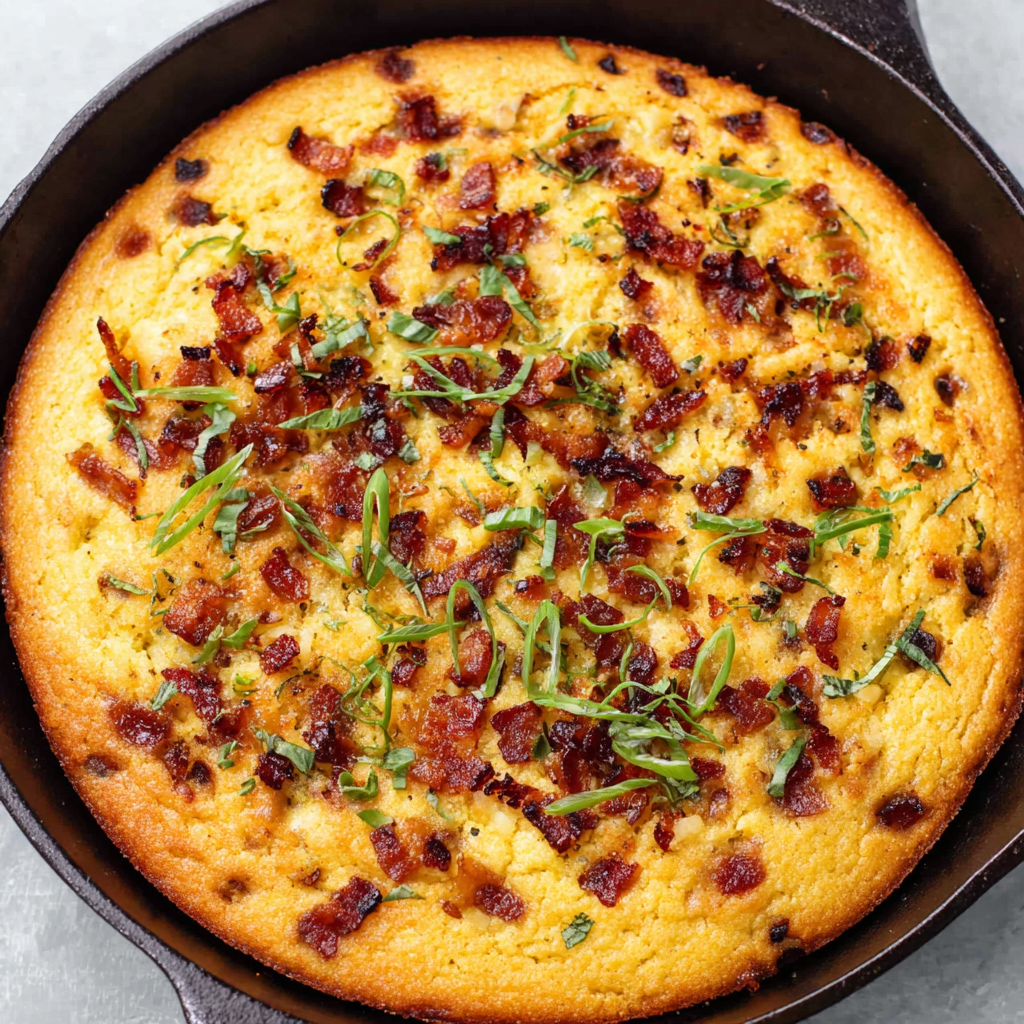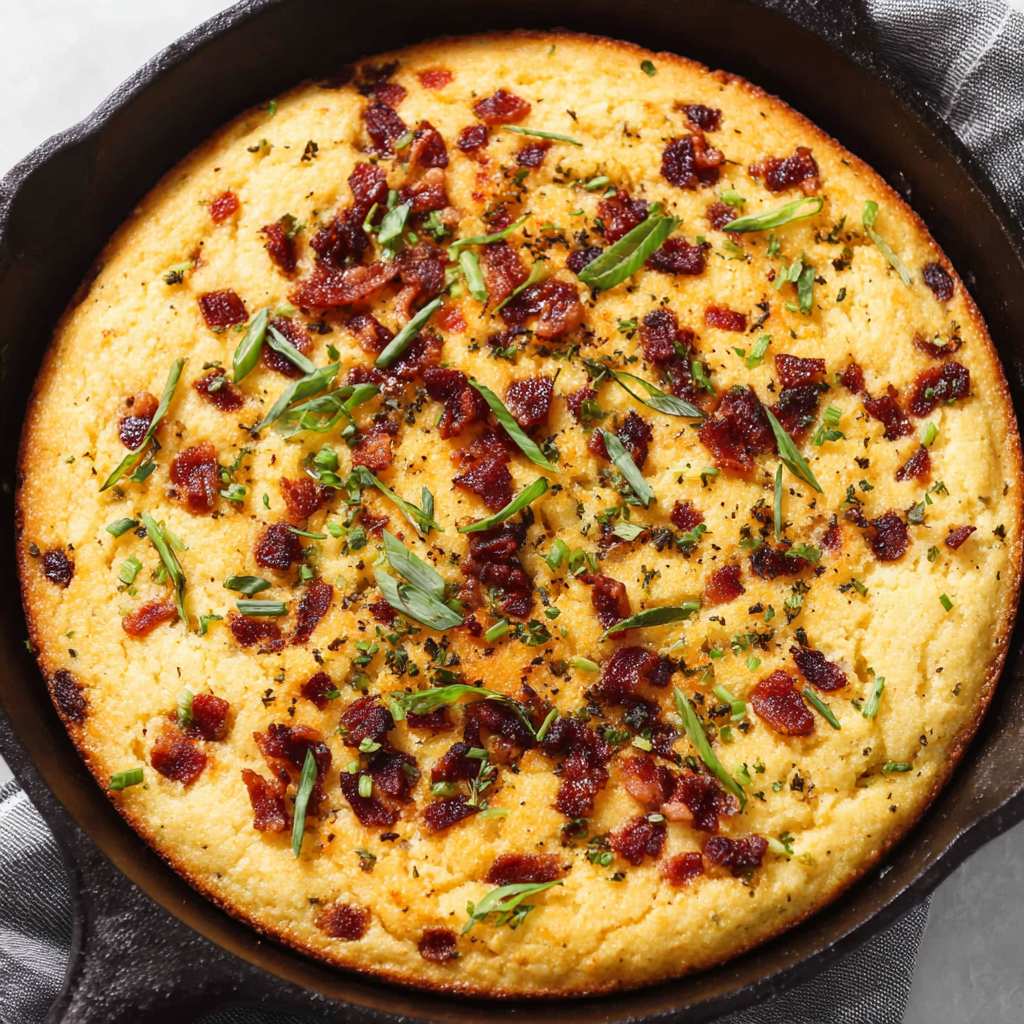1. Introduction to the Recipe
Few dishes strike the perfect balance between rustic comfort and sophisticated flavor the way a Skillet Pancetta Corn Casserole does. This dish is warm, hearty, and deeply satisfying, yet elevated through the use of ingredients such as pancetta, basil, sun-dried tomatoes, and Parmesan cheese. It blends sweet corn kernels with rich dairy and savory cured meat to create an irresistible side—or even main dish—that works for holidays, weekend dinners, brunch spreads, potlucks, and cozy gatherings. Served straight from a cast-iron skillet, it presents beautifully and maintains heat exceptionally well, making it ideal for both casual and elegant occasions.
The magic of this casserole begins with the pancetta, which infuses the dish with its distinctly smoky, salty depth. Combined with sun-dried tomatoes in oil, this base layer adds both richness and tang that contrast beautifully with the sweetness of the corn. Instant polenta (or cornmeal) helps bind the casserole, giving it subtle structure without making it dense. The result is a soft, spoonable interior with a golden, lightly crisp top, thanks to Parmesan and the even heat of the skillet. Meanwhile, heavy cream and sour cream deliver luxurious richness, creating a silky, comforting texture that pairs perfectly with the bright, fresh notes of basil.
If you love the idea of skillet-based comfort food, you might enjoy exploring guides on seasoning and maintaining cast-iron cookware . Proper cast-iron care ensures dishes like this Skillet Pancetta Corn Casserole bake evenly and develop beautifully browned edges. For those curious about specialty cured meats, this article on pancetta vs. bacon can help deepen your understanding of flavor profiles. Both resources complement the cooking process and help elevate your skillet dishes even further.
Whether served alongside grilled meats, roasted vegetables, holiday ham, or enjoyed as a standalone brunch centerpiece, this casserole is wonderfully versatile. It takes familiar ingredients and transforms them into a richly layered dish with Italian-inspired flair. The combination of creamy texture, savory pancetta, and sweet pops of corn makes it a crowd-pleaser wherever it’s served. With minimal prep and a beautifully rustic presentation, this Skillet Pancetta Corn Casserole is sure to become one of your favorite comfort-food recipes to return to again and again.
2. Basic Recipe: Ingredients and Instructions
Print
Skillet Pancetta Corn Casserole Recipe
Description
This Skillet Pancetta Corn Casserole blends smoky pancetta, sweet corn, and Parmesan in a rich, creamy baked skillet.
Ingredients
- 1 tablespoon olive oil
- 4 ounces pancetta, diced
- ½ cup sun-dried tomatoes in oil, chopped
- 1 cup Instant polenta (or cornmeal)
- 1 tablespoon baking powder
- ½ teaspoon salt
- 2 eggs, beaten
- 1 cup sour cream
- 1 cup heavy cream
- 1 ½ cups corn kernels (fresh, frozen, or canned)
- 6 leaves fresh basil, chiffonade (plus more for garnish)
- ¾ cup Parmesan cheese, shredded
Instructions
- Preheat & Prepare the Skillet
Preheat your oven to 375°F (190°C). Heat olive oil in a cast-iron skillet over medium heat. - Cook the Pancetta
Add diced pancetta to the skillet. Cook 5–7 minutes, stirring occasionally, until crispy and golden. Leave the rendered fat in the skillet for added flavor. - Add Sun-Dried Tomatoes
Stir in chopped sun-dried tomatoes and cook for an additional minute to blend flavors. Remove skillet from heat. - Mix Dry Ingredients
In a large bowl, combine instant polenta, baking powder, and salt. - Combine Wet Ingredients
In another bowl, whisk together eggs, sour cream, and heavy cream until smooth. - Bring It All Together
Add the wet mixture to the dry mixture, stirring until just combined. Fold in corn kernels, basil, Parmesan, and the pancetta mixture. - Bake the Casserole
Pour the mixture back into the skillet. Spread evenly. Bake for 25–35 minutes, or until puffed, golden, and set in the center. - Garnish & Serve
Let rest 10 minutes. Top with additional basil for a fresh, aromatic finish.
Notes
Fresh corn offers the sweetest flavor, but frozen works beautifully without thawing.
Parmesan can be swapped for Pecorino Romano for a sharper flavor.
If using standard cornmeal instead of polenta, texture will be slightly denser.
For a spicier version, add red pepper flakes or diced jalapeños.
3. Advanced Techniques
1. Crisping Pancetta for Maximum Flavor
Perfectly crisp pancetta is essential for developing the deep savory foundation of this Skillet Pancetta Corn Casserole. Cook it slowly over medium heat to allow fat to render without burning. When pancetta cooks too quickly, it browns on the outside but stays chewy inside, leaving behind less flavorful fat. Let it reach a deep amber color before removing from heat. The rendered fat should stay in the skillet—it’s valuable flavor that enhances the corn mixture. If you want an extra-crispy result, spread pancetta on a paper towel-lined plate after cooking, then fold it into the batter just before baking.
2. Optimizing Skillet Heat for Even Baking
Corn-based casseroles bake best in cast-iron because cast iron retains heat evenly, creating a perfectly puffed texture. Preheating your skillet slightly before adding the batter helps form a subtle crust around the edges. Just make sure the skillet isn’t piping hot when adding the batter—otherwise the bottom may burn before the casserole sets. The goal is gentle heat distribution that allows the moisture from the cream and sour cream to create steam pockets, giving the final dish its airy, tender interior. Mastering this balance elevates the casserole from ordinary to exceptional.
3. Balancing Sweet Corn With Savory Mix-Ins
One of the most appealing features of this casserole is its balance of sweet and savory flavors. Fresh, crisp corn pairs deliciously with salty pancetta, tangy sun-dried tomatoes, and the richness of heavy cream. To enhance sweetness, you can sauté the corn briefly in a teaspoon of pancetta fat before adding it to the batter. For deeper savory notes, increase Parmesan or add a touch of cracked black pepper. Basil provides refreshing contrast—add it at the final mixing stage to preserve its vibrant flavor and prevent it from turning bitter during baking.
4. Achieving the Perfect Texture With Polenta
Instant polenta offers a soft, velvety texture that sets this dish apart from typical corn casseroles. To prevent clumping, mix polenta thoroughly into the dry ingredients before adding liquid. Once the wet mixture is folded in, avoid overmixing—the more you mix, the denser the casserole becomes. If you prefer a firmer structure, let the mixture sit for 5 minutes before baking to allow the polenta to hydrate slightly. For a creamier result, increase heavy cream by ¼ cup. Whether you choose dense or fluffy, polenta lets you fine-tune texture with ease.
5. Developing a Golden, Flavorful Crust
A golden crust adds both flavor and visual appeal. Parmesan helps brown the top naturally thanks to its fat and salt content, but technique matters, too. Spread the mixture evenly to avoid uneven browning. For a deeper golden finish, sprinkle an extra tablespoon of Parmesan over the top right before baking. You can also lightly drizzle the surface with a half teaspoon of olive oil. If your oven has a convection setting, switching to convection for the last 5 minutes of baking crisps the top beautifully without drying out the interior.

4. Storage, Shelf Life, and Maintenance Tips
1. Storing at Room Temperature
This casserole is best when enjoyed warm, but it can safely sit at room temperature for up to 2 hours after baking. Leaving it uncovered during this time helps preserve the crisp top. Covering while warm traps steam and softens the crust. If serving buffet style, keep the skillet on the table as-is—it retains heat well and enhances presentation. After the 2-hour mark, leftovers should be refrigerated for safety and freshness.
2. Refrigerating for Multi-Day Enjoyment
Refrigeration keeps this casserole fresh for 3–4 days. Allow it to cool fully before covering. Use a loose foil tent instead of an airtight container to preserve texture. When ready to reheat, cover with foil and warm in a 325°F oven for 10–15 minutes. The steam trapped under the foil rehydrates the interior while preventing over-browning. Basil garnish should be added fresh after reheating, as chilled basil can darken and lose aroma.
3. Freezing for Meal Prep or Future Events
This casserole freezes surprisingly well thanks to its creamy base and polenta structure. Slice into portions, wrap each tightly in plastic wrap, then place pieces in a freezer-safe container. Freeze for up to 2 months. To serve, thaw slices overnight in the refrigerator, then reheat covered in the oven at 325°F. Avoid microwaving directly from frozen as it may cause uneven heating or rubbery texture. The flavors mellow slightly when frozen, making reheated portions especially cohesive and aromatic.
4. Maintaining Crisp Texture After Storage
Stored casseroles tend to lose their top-layer crispness as they absorb moisture. To revive texture, reheat uncovered for the last 5 minutes of warming. A very light broil (1–2 minutes) can restore golden edges—just watch closely to prevent burning. Adding a fresh sprinkle of Parmesan before reheating enhances both flavor and browning. For a slightly richer crust, drizzle a few drops of olive oil over the top before reheating.
5. Transporting the Casserole Safely
For potlucks, holidays, or family gatherings, this casserole travels extremely well. Keep it in the skillet or transfer to a lidded casserole dish. Wrap in a thick towel to retain heat. If transporting cold for later reheating, store basil garnish separately. Casseroles transported in cast iron stay warm longer, making the skillet version ideal for serving outdoors or buffet-style events.

5. Dietary Adaptations and Substitutions
1. Gluten-Free Adaptation
This Skillet Pancetta Corn Casserole is naturally gluten-free provided you use pure polenta or labeled gluten-free cornmeal. Always check baking powder for gluten-free certification. The remaining ingredients—creams, eggs, Parmesan, corn, pancetta—contain no gluten. For those highly sensitive to cross-contamination, verify that sun-dried tomatoes and pancetta come from gluten-free facilities. The texture of the casserole remains identical whether made traditionally or gluten-free.
2. Low-Carb or Keto Modifications
While polenta adds structure, it also contributes carbs. For a low-carb variation, skip the polenta entirely and add an extra ½ cup Parmesan plus an additional egg to help bind the mixture. The resulting casserole will be more custard-like but still creamy and rich. You can also incorporate more pancetta or low-carb vegetables like spinach, mushrooms, or roasted peppers. This adaptation maintains savory flavor while significantly reducing carbohydrates.
3. Dairy-Free Version
To make the casserole dairy-free, substitute sour cream with coconut cream and heavy cream with full-fat coconut milk. Choose a dairy-free Parmesan-style cheese or nutritional yeast for a nutty finish. The texture will be slightly looser, as coconut products don’t thicken in the same way dairy does, but the dish remains flavorful and satisfying. Sun-dried tomatoes and pancetta add richness that compensates for the lighter base.
4. Vegetarian Adaptation
To make this casserole vegetarian, simply omit the pancetta. For extra savoriness, add ½ teaspoon smoked paprika or use finely diced, sautéed mushrooms as a flavorful substitute. Sun-dried tomatoes still bring depth and umami, ensuring the finished dish isn’t lacking in richness. You can also increase Parmesan to resist dryness and boost flavor in the absence of pancetta fat.
5. Nut-Free and Allergen-Friendly Adjustments
This recipe is naturally nut-free and suitable for those with common nut allergies. Just be sure to check labels on sun-dried tomatoes, which sometimes share equipment with tree nut products. For school-safe versions, bake in a casserole dish rather than cast iron, since some schools do not allow heavy cookware. The flavor and texture remain consistent across allergen-friendly modifications.

6. FAQs About the Recipe
1. Can I Make This Ahead of Time?
Yes! This casserole is an excellent make-ahead dish. You can fully assemble the mixture and refrigerate it in the skillet (or baking dish) for up to 24 hours before baking. Let it sit at room temperature for 20 minutes before placing it in the oven. Alternatively, fully bake it the day before, refrigerate, and reheat covered at 325°F. Both methods preserve flavor, though assemble-ahead gives the freshest texture.
2. Do I Have to Use a Cast-Iron Skillet?
No, a cast-iron skillet is ideal but optional. A 9- or 10-inch baking dish works perfectly. Cast iron simply provides superior heat retention, which helps develop golden edges and deep flavor. If using ceramic or glass, add 5–10 minutes to the total bake time and keep an eye on browning. Metal pans mimic cast iron more closely and offer even heating with similar results.
3. Can I Use Fresh Instead of Sun-Dried Tomatoes?
Fresh tomatoes can be used, but they lack the concentrated flavor sun-dried tomatoes provide. If substituting fresh, choose Roma or plum tomatoes, remove seeds, chop finely, and sauté briefly to reduce moisture. Add a tablespoon of olive oil to replace the richness typically contributed by oil-packed sun-dried tomatoes. The final flavor will be lighter and slightly sweeter but still delicious.
4. Why Is My Casserole Too Dense?
Overmixing polenta or cornmeal is the most common cause of density. Mix the batter only until combined. Another cause is using coarser cornmeal, which absorbs more liquid and requires more cream. Add an additional ¼ cup heavy cream next time for a softer texture. Lastly, ensure baking powder is fresh—expired baking powder reduces the rise and makes the dish more compact.
5. What Goes Well With This Casserole?
This casserole pairs beautifully with grilled chicken, roast pork, barbecue dishes, fresh salads, or roasted vegetables. It also shines at brunch with eggs, sausage links, or a simple fruit salad. Because the flavors are rich and savory, pairing with lighter dishes balances the meal well. As a standalone meal, it works perfectly with a crisp green salad topped with lemon vinaigrette.

7. Conclusion & Final Thoughts
Skillet Pancetta Corn Casserole is the kind of dish that feels like comfort food yet carries enough sophistication to serve at festive gatherings or special events. Its combination of sweet corn, creamy dairy, savory pancetta, and bright basil creates a delightful harmony of flavors in every bite. Baked in a cast-iron skillet, it emerges golden, aromatic, and deeply satisfying, with irresistible edges and a soft, custard-like center. Whether made as a hearty side dish or enjoyed as a main entrée, its flavors are rich enough to stand alone while pairing effortlessly with roasted meats or fresh salads.
This casserole has a classic appeal but also a touch of modern flair thanks to its Italian-inspired ingredients. Pancetta and sun-dried tomatoes bring depth and brightness that lift the entire dish beyond traditional corn casseroles. Polenta adds a velvety texture that makes the mixture feel luxurious without becoming heavy. The finishing touch of basil delivers a burst of freshness that keeps each bite lively, balanced, and memorable.
Because it comes together quickly using common ingredients, it’s perfect for busy weeknights. Yet its presentation in a rustic cast-iron skillet makes it worthy of holiday tables and celebratory meals. It reheats beautifully, serves easily, and always garners praise from guests. Whether you prepare it once or make it a recurring favorite, this Skillet Pancetta Corn Casserole offers warmth, comfort, and beautifully layered flavors suited for any season.
